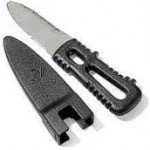Don’t Go Out Without Your PFD Knife
 If you plan to kayak, you also must plan for potential survival situations. Whether you are on the water alone or with a group, there may come a time when you need out of that kayak in as few seconds as possible. Even when you are surrounded by other people, there may not be time for someone else to come to your aid. You may get out of the kayak only to have it swept away and leave you marooned. You would never think of getting into your kayak without your personal flotation device (PFD). You should feel exactly the same way about carrying a knife that attaches to your PFD.
If you plan to kayak, you also must plan for potential survival situations. Whether you are on the water alone or with a group, there may come a time when you need out of that kayak in as few seconds as possible. Even when you are surrounded by other people, there may not be time for someone else to come to your aid. You may get out of the kayak only to have it swept away and leave you marooned. You would never think of getting into your kayak without your personal flotation device (PFD). You should feel exactly the same way about carrying a knife that attaches to your PFD.
Why Do I Need a Knife on My PFD? It is easy to imagine any number of possible scenarios where a knife on your PFD could prove not just useful, but essential. There are so many ways that having such a knife could save your life on the water when you are out kayaking. A PFD knife could save your life during an animal attack. A knife can save you if you get tangled in debris or netting. A good, easy to reach PFD knife also could mean the difference between getting out of your kayak in a bad situation and not getting out in time. If something happens to your kayak and you get stranded on a river bank, you will certainly be thankful for that knife when you are in a dry land survival situation.
What Kind of Knife Should I Carry? Obviously, a blade that is not going to rust is one of the most important considerations, but there are several other factors as well. You need a knife that can be easily attached to your PFD via karabiner, without the danger that a jump ring will break away or come loose. In addition, since a knife with a fixed blade will be much more easily accessible in a life or death situation, you need a blade without a sharp tip so that you won’t be in danger of an ironic death, accidentally stabbed by your survival equipment, if the sheath comes off. There is much to be said on the subject of flat versus serrated edges, but a knife that has both ends the need for a debate on the subject. Either or both might come in handy, so bring a knife with options. It should be no longer than five or six inches.
The knife must not only be relatively water-proof, but also durable. Before you take a PFD knife out on the water, test it at home. Use it to pry open a few things and see if it holds together or if there is suspicious give when it is placed under a strain. If it feels like the handle might come off, then you don’t want to depend on it for your survival.
How Should I Attach the Knife? How you affix the knife to your PFD is partially personal preference, but whether you use just a carabiner, a chain or a retractable cord, the main concern is how accessible the knife will be if you only have one hand free to grab it and use it. Can you detach it from the PFD in no more than a few seconds? On the other hand, it must be secure enough that it won’t come free during extreme conditions. It should also reattach relatively easily.
In the end, regardless of what kind of knife you buy or how it fastens to your PFD, the most important thing is that you have a PFD knife when you need it.
